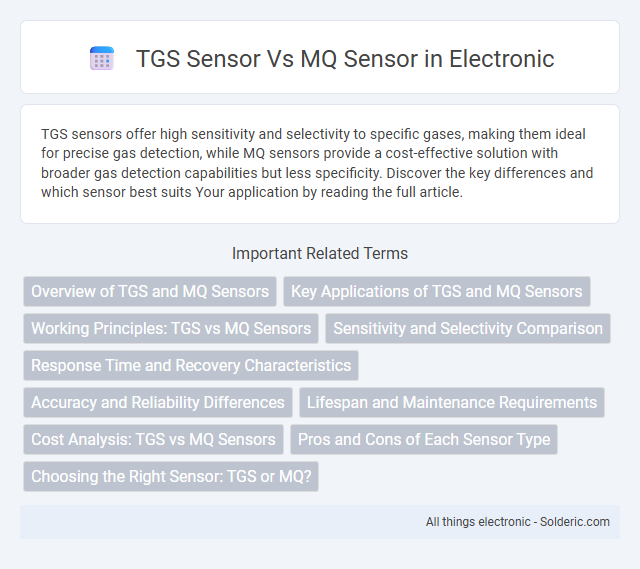TGS sensors offer high sensitivity and selectivity to specific gases, making them ideal for precise gas detection, while MQ sensors provide a cost-effective solution with broader gas detection capabilities but less specificity. Discover the key differences and which sensor best suits Your application by reading the full article.
Comparison Table
| Feature | TGS Sensor | MQ Sensor |
|---|---|---|
| Manufacturer | Figaro Engineering Inc. | Hanwei Electronics |
| Sensitivity | High selectivity to specific gases | Broad gas detection, less selective |
| Gas Types Detected | Specific gases (e.g., methane, LPG, CO) | Multiple gases (e.g., MQ-2: LPG, smoke, MQ-7: CO) |
| Response Time | Fast response time (seconds) | Moderate response time (seconds) |
| Operating Voltage | Typically 5V | Typically 5V |
| Output Type | Analog voltage output | Analog voltage output |
| Application | Industrial gas leak detection, safety systems | General-purpose gas detection, hobby projects |
| Cost | Higher price due to specificity | Lower cost, widely available |
| Durability | Robust and stable over time | Less stable, requires frequent calibration |
Overview of TGS and MQ Sensors
TGS sensors, developed by Figaro Engineering, are semiconductor gas sensors widely used for detecting gases like carbon monoxide, methane, and volatile organic compounds with high sensitivity and fast response times. MQ sensors, produced by Hanwei Electronics, are low-cost metal oxide semiconductor gas sensors designed for a broad range of gases including LPG, smoke, alcohol, and ammonia, making them popular in hobbyist and industrial applications. Both TGS and MQ sensors operate on changes in electrical resistance when exposed to target gases, but TGS sensors typically offer higher stability and accuracy in professional settings compared to the more affordable MQ sensor series.
Key Applications of TGS and MQ Sensors
TGS sensors excel in detecting combustible gases and volatile organic compounds, making them ideal for applications in gas leak detection, air quality monitoring, and safety systems in industrial environments. MQ sensors are widely used for detecting gases like methane, carbon monoxide, and LPG in household safety devices, environmental monitoring, and automotive air quality systems. Both sensors serve crucial roles in gas detection technology, with TGS sensors favored for precision and MQ sensors valued for cost-effective, wide-range gas detection.
Working Principles: TGS vs MQ Sensors
TGS sensors operate using metal oxide semiconductor technology that detects gas concentration by changes in resistance when target gases interact with the sensor surface. MQ sensors function similarly but typically employ a simpler heating element and sensing material, producing a variable voltage output proportional to gas concentration. Both sensors rely on changes in electrical properties due to gas adsorption, yet TGS sensors often offer higher sensitivity and selectivity for specific gases compared to the more general-purpose MQ sensors.
Sensitivity and Selectivity Comparison
TGS sensors offer higher sensitivity to a specific range of gases, making them ideal for detecting low concentrations with greater accuracy. MQ sensors provide broader gas detection capabilities but often lack the selectivity needed to distinguish between similar gases effectively. Choosing the right sensor depends on whether your application prioritizes precise sensitivity or versatile gas detection.
Response Time and Recovery Characteristics
TGS sensors typically exhibit faster response times compared to MQ sensors, making them more suitable for applications requiring quick detection of gases. Recovery characteristics in TGS sensors are generally quicker as well, allowing the sensor to return to baseline levels promptly after exposure. MQ sensors often have longer recovery times due to their heating element design, which can delay the sensor's readiness for subsequent measurements.
Accuracy and Reliability Differences
TGS sensors generally offer higher accuracy and long-term stability compared to MQ sensors due to their advanced sensing materials and better manufacturing processes. MQ sensors tend to have faster response times but may exhibit more variability and drift over time, affecting reliability in consistent measurements. Your choice between TGS and MQ sensors should consider accuracy needs and maintenance frequency for optimal performance in air quality monitoring.
Lifespan and Maintenance Requirements
TGS sensors typically offer a longer lifespan compared to MQ sensors due to their more durable construction and stable sensor elements, requiring less frequent replacement. MQ sensors often need regular calibration and cleaning to maintain accuracy, increasing maintenance efforts. Your choice depends on whether you prioritize lower upkeep with TGS or a more cost-effective but higher-maintenance MQ sensor.
Cost Analysis: TGS vs MQ Sensors
TGS sensors generally have a higher manufacturing cost due to their advanced semiconductor materials and precise gas detection technology, resulting in improved sensitivity and stability. MQ sensors offer a more budget-friendly option with simpler construction, making them ideal for cost-sensitive applications but with lower accuracy and shorter lifespan. Your choice between TGS and MQ sensors should weigh the initial investment against the desired performance and long-term reliability.
Pros and Cons of Each Sensor Type
TGS sensors offer high sensitivity and stability in detecting gases like methane and carbon monoxide but tend to have slower response times and higher power consumption compared to MQ sensors. MQ sensors provide rapid response, lower cost, and ease of use for detecting a broad range of gases including LPG and smoke, but they may suffer from lower selectivity and shorter lifespan. Choosing between TGS and MQ sensors depends on application requirements such as accuracy, response speed, and operating environment.
Choosing the Right Sensor: TGS or MQ?
Choosing the right sensor between TGS and MQ depends on your specific gas detection needs and environmental conditions. TGS sensors, developed by Figaro, offer high sensitivity and long-term stability for detecting gases like methane and propane, making them ideal for industrial applications. MQ sensors provide more cost-effective solutions with a broad range of gas detection capabilities, suited for hobbyist and general-purpose uses, allowing you to select based on accuracy and budget requirements.
TGS sensor vs MQ sensor Infographic

 solderic.com
solderic.com